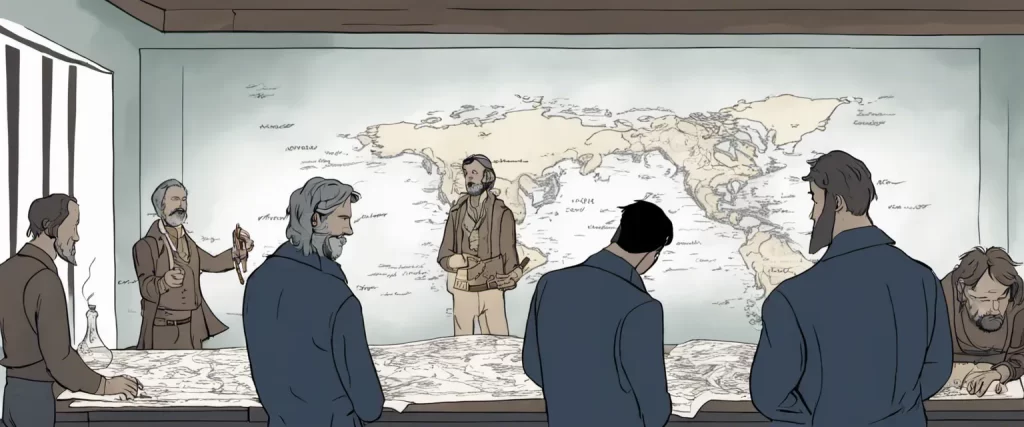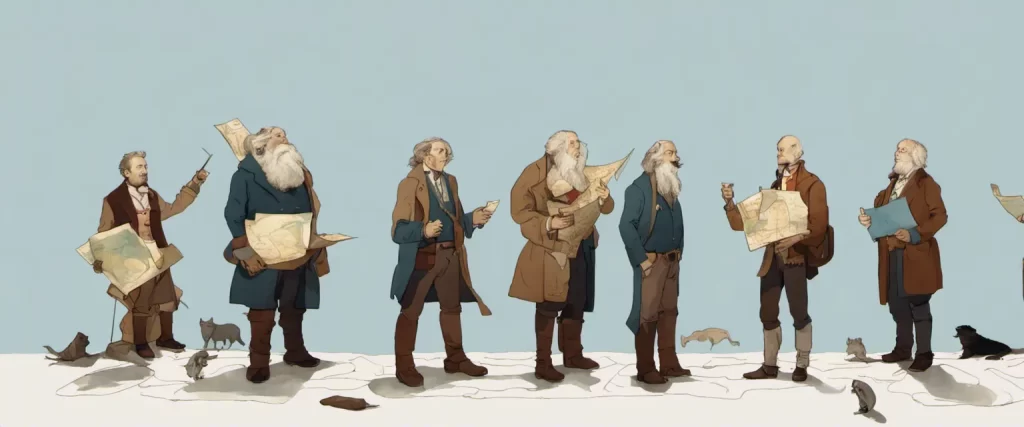——The Sea Wolves by Lars Brownworth & The Rape of Nanking by Iris Chang
In the vast realm of historical literature, certain narratives have the power to shake the foundations of our understanding, unraveling the darkest chapters of human history. Lars Brownworth’s “The Sea Wolves” and Iris Chang’s “The Rape of Nanking” stand as notable examples of such works, vividly documenting two distinct but equally devastating atrocities. While Brownworth delves into the spine-chilling saga of Viking invasions during the Middle Ages, Chang meticulously explores the harrowing events that transpired during the infamous Nanking Massacre of 1937.
The Sea Wolves” beckons readers to an era marred by violence and conquest, where the Vikings emerged as formidable warriors and daring seafarers. In contrast, “The Rape of Nanking” unfurls a gruesome tale of imperial aggression, recounting the infamous episode of Japanese military brutality against the Chinese population in the wake of their occupation of Nanking. As we embark on this comparative study, we will explore the historical contexts, narrative approaches, and overarching themes found within these two books, drawing connections between these tragic incidents of human cruelty.
Contextualizing historical events is paramount to understanding their significance and implications on our collective memory. Brownworth, renowned for his prowess in bringing history to life, skillfully transports readers to a tumultuous period, depicting the Vikings’ audacious raids on European shores during the 8th to 11th centuries. In parallel, Chang provides a precise and insightful account of the Nanking Massacre’s origins, examining the political, social, and military factors that fostered such a horrific event under the Japanese Empire.
By investigating the narrative approaches employed by both authors, we decipher the distinctive methods through which they bring their stories to light. Brownworth’s storytelling unfolds through a gripping blend of meticulous research interwoven with captivating anecdotes, cultivating an immersive experience that ignites the readers’ imagination. Chang, on the other hand, adopts a more journalistic style, relying on extensive eyewitness testimonies and harrowing survivor accounts to illustrate the tragic reality of the atrocities committed in Nanking.
As we delve deeper into our exploration, it becomes increasingly apparent that these accounts share a common thread, the recurrent theme of human suffering and resilience. Despite the vastly different time periods and geographical locations, both narratives serve as stark reminders of the inescapable darkness that can envelope humanity under certain circumstances. Through a careful analysis of Brownworth’s “The Sea Wolves” and Chang’s “The Rape of Nanking,” we hope to draw parallels, discern patterns, and unravel the human capacity for both unspeakable cruelty and astonishing resilience.
In the ensuing chapters, we will journey into the intricate web of history spun by these two esteemed authors, analyzing the underlying socio-political dynamics, shedding light on the impacts of these incidents, and ultimately contributing to a deeper understanding of the human condition. As we tread this path of inquiry, we recognize the importance of contemplating these historical atrocities, for it is through the harsh lessons of the past that we can strive to create a more compassionate and tolerant future.
Brief Summary of Two Books
The Sea Wolves by Lars Brownworth
The Sea Wolves” by Lars Brownworth is a historical book that explores the fascinating world of the Viking Age and the importance of their naval strength. The author takes readers on a thrilling journey back in time and delves into the actions and exploits of the Vikings, known as the “Sea Wolves”, who were masters of the sea during the period spanning the 8th and 11th centuries.
Brownworth introduces various Viking leaders and their unique paths to becoming formidable naval powers. He discusses famous Vikings such as Ragnar Lothbrok, Harald Bluetooth, and Olaf Tryggvason, as well as lesser-known figures like Thorkell the Tall and Cnut the Great. The author not only highlights their ferocious raids and plundering along the coasts of Europe, but also dives into their remarkable military strategies and innovations in shipbuilding.
Throughout the book, Brownworth explores the turbulent political landscape of Europe during this time, and explains how Viking invasions and settlements deeply impacted the history and cultures of various regions. He reflects upon the Vikings’ interactions with prominent leaders and dynasties, such as Charlemagne and the Anglo-Saxons, revealing the lasting legacy of these Norse seafarers.
“The Sea Wolves” offers readers a comprehensive understanding of the Vikings’ impact on European history, focusing specifically on their naval dominance and the consequent influence on the social, political, and economic landscapes of the time. Brownworth’s engaging storytelling style makes this historical account accessible and captivating, shedding light on a crucial era of maritime exploration and conflict that still resonates today.
The Rape of Nanking by Iris Chang
“The Rape of Nanking” by Iris Chang is a non-fiction book that narrates the horrific events that took place during the Japanese invasion of Nanking (now Nanjing) in China in 1937. The book sheds light on the atrocities committed by Japanese troops against Chinese civilians and soldiers during the six-week occupation.
Chang starts by providing historical context, detailing the political climate that led to the invasion and the Japanese military’s mindset. She then delves into the actual events, often relying on survivor testimonies, diaries, and historical records to convey the brutality and scale of the violence.
The book describes the systematic rape and sexual assault of tens of thousands of Chinese women, including children and elderly, highlighting the profound physical and psychological trauma inflicted upon them. Chang also discusses the mass murder and mutilation of Chinese civilians, the widespread torture and forced labor, as well as the deliberate destruction of cultural heritage and historical artifacts.
Chang examines the international response and the efforts of western individuals and institutions to provide aid and document the atrocities. She also discusses the struggles faced by survivors to seek justice and international recognition for the crimes committed against them.
“The Rape of Nanking” is a comprehensive account of one of the darkest chapters in modern history, exposing the inhumanity of war and the lasting impact it has on a nation and its people. The book aims to educate readers about the forgotten tragedy of Nanking and to advocate against the repetition of such acts of violence and genocide.
Comparison between Two Books

Similarities in Historic Spotlight
The Sea Wolves by Lars Brownworth and The Rape of Nanking by Iris Chang are two historically focused books that shed light on significant events from different periods in history. While the topics and timeframes may differ, there are several similarities in terms of their historic spotlight that can be identified in both books.
1. Exploration of lesser-known events: Both books aim to bring attention to historical events that have not received as much prominence in mainstream narratives. The Sea Wolves focuses on the Vikings and their impact on history, particularly their exploration and conquests, while The Rape of Nanking delves into the often overlooked atrocity committed by the Japanese army during their invasion of Nanking in 1937. Both books shed light on lesser-known aspects of history, giving the reader a broader understanding of these events.
2. In-depth research and analysis: Both authors undertook extensive research to present a thorough and detailed account of the events they explored. Lars Brownworth and Iris Chang utilized a wide range of sources, including primary documents, interviews, and historical records, to provide accurate and comprehensive narratives that go beyond surface-level descriptions. This commitment to research is evident in both books, enhancing their credibility and allowing readers to gain deeper insights into the events.
3. Presentation of multiple perspectives: Both authors strive to present a balanced view by incorporating multiple perspectives. In The Sea Wolves, Lars Brownworth examines historical sources that offer insights into the Vikings from various angles, including those of the Vikings themselves, their victims, and neighboring societies. Similarly, Iris Chang explores different perspectives in The Rape of Nanking by including accounts from both Chinese survivors and Japanese soldiers. This multifaceted approach helps readers develop a broader understanding of the events and the impact they had on different individuals and communities.
4. Humanization of historical figures: Both books humanize the people involved in the events they focus on. Rather than merely portraying the Vikings as ruthless raiders or the Japanese soldiers as mindless perpetrators, the authors delve into the personal experiences, motivations, and backgrounds of historical figures involved. By highlighting their individual stories and exploring their emotions and actions, both books help readers to better understand the complex nature of historical events and the people who shaped them.
In summary, The Sea Wolves and The Rape of Nanking share similarities in their historic spotlight by scrutinizing lesser-known events, conducting extensive research, presenting multiple perspectives, and humanizing historical figures. Through these approaches, both books contribute to a deeper understanding of the past and the impact of these events on our world today.
Divergences in Historic Spotlight
The Sea Wolves by Lars Brownworth and The Rape of Nanking by Iris Chang are both historical books that shed light on different periods and events in history. While they cover separate topics and time periods, there are distinct divergences in their approach, focus, and the historical spotlight they shed.
1. Topics and Time Periods:
– The Sea Wolves: The book by Lars Brownworth focuses on the Viking Age, particularly the story of the Norsemen who raided and explored Europe from the late 8th to the 11th centuries. It examines the Viking culture, their voyages, and their impact on European history.
– The Rape of Nanking: Iris Chang’s book, on the other hand, tackles the brutal invasion of Nanking (now Nanjing), China, by the Imperial Japanese Army in 1937. It documents the atrocities committed by the Japanese soldiers against Chinese civilians and soldiers during the occupation of the city.
2. Geographic Focus:
– The Sea Wolves: Lars Brownworth’s book has a broader geographic focus as it explores Viking activities across various parts of Europe, including regions like Scandinavia, the British Isles, and even as far as North Africa and the Middle East.
– The Rape of Nanking: Iris Chang’s book primarily centers on the city of Nanking in China and the specific events that occurred during the occupation by the Japanese army. The geographic scope remains more localized within the context of the city and its surroundings.
3. Historical Treatment:
– The Sea Wolves: Brownworth’s book takes a more historical overview approach, discussing the broader themes, cultural aspects, and significant events related to the Viking Age. It aims to provide a comprehensive understanding of the Viking era, focusing on key individuals, journeys, and their ultimate impact.
– The Rape of Nanking: Chang’s book presents a more detailed exposé specifically on the atrocities committed during the occupation of Nanking. Chang leverages extensive research, personal testimonies, and survivor accounts to vividly portray the horrors inflicted on the city’s populace, making it a deeply harrowing and disturbing narrative.
4. Historical Significance:
– The Sea Wolves: Brownworth’s book highlights the historical significance of the Viking Age and its impact on Europe’s trajectory. It explores Viking contributions to trade, exploration, and the blending of cultural influences across vast regions.
– The Rape of Nanking: Chang’s book sheds light on a comparatively lesser-known event in Western history, bringing the Nanking Massacre to the forefront. It aims to ensure that one of the most brutal episodes of the 20th century is not forgotten and acts as a lasting tribute to the victims.
In summary, while The Sea Wolves by Lars Brownworth focuses on the Viking Age and its wide-ranging impact on Europe, The Rape of Nanking by Iris Chang delves into the specific atrocities committed during the occupation of Nanking. These books diverge in their geographic focus, historical treatment, and the historical significance they shed light on.

Conclusion
Both “The Sea Wolves” by Lars Brownworth and “The Rape of Nanking” by Iris Chang are highly regarded and important books in their respective subjects. However, each book covers different topics and it ultimately depends on the reader’s personal interests and preferences.
“The Sea Wolves” by Lars Brownworth delves into the history of the Vikings, exploring their seafaring adventures, conquests, and impact on European history. It provides a comprehensive and well-researched account of the Viking Age, making it a fascinating read for those interested in medieval history, Norse mythology, or maritime exploration.
“The Rape of Nanking” by Iris Chang tackles a tragic and deeply disturbing event in history, recounting the massacre and atrocities committed by the Imperial Japanese Army in Nanking (now Nanjing), China, during the Sino-Japanese War in 1937. This book sheds light on a lesser-known historical event that highlights the horrors of war and the experiences of the victims. It is a thought-provoking and essential read for those interested in World War II, human rights, or the examination of mass violence.
Therefore, the choice between these two books depends on the reader’s preferences and interests. If you are more interested in Viking history and exploration, “The Sea Wolves” would be the more worthy choice. Conversely, if you are looking to expand your knowledge of World War II history and its brutal consequences, “The Rape of Nanking” would be the recommended option.



